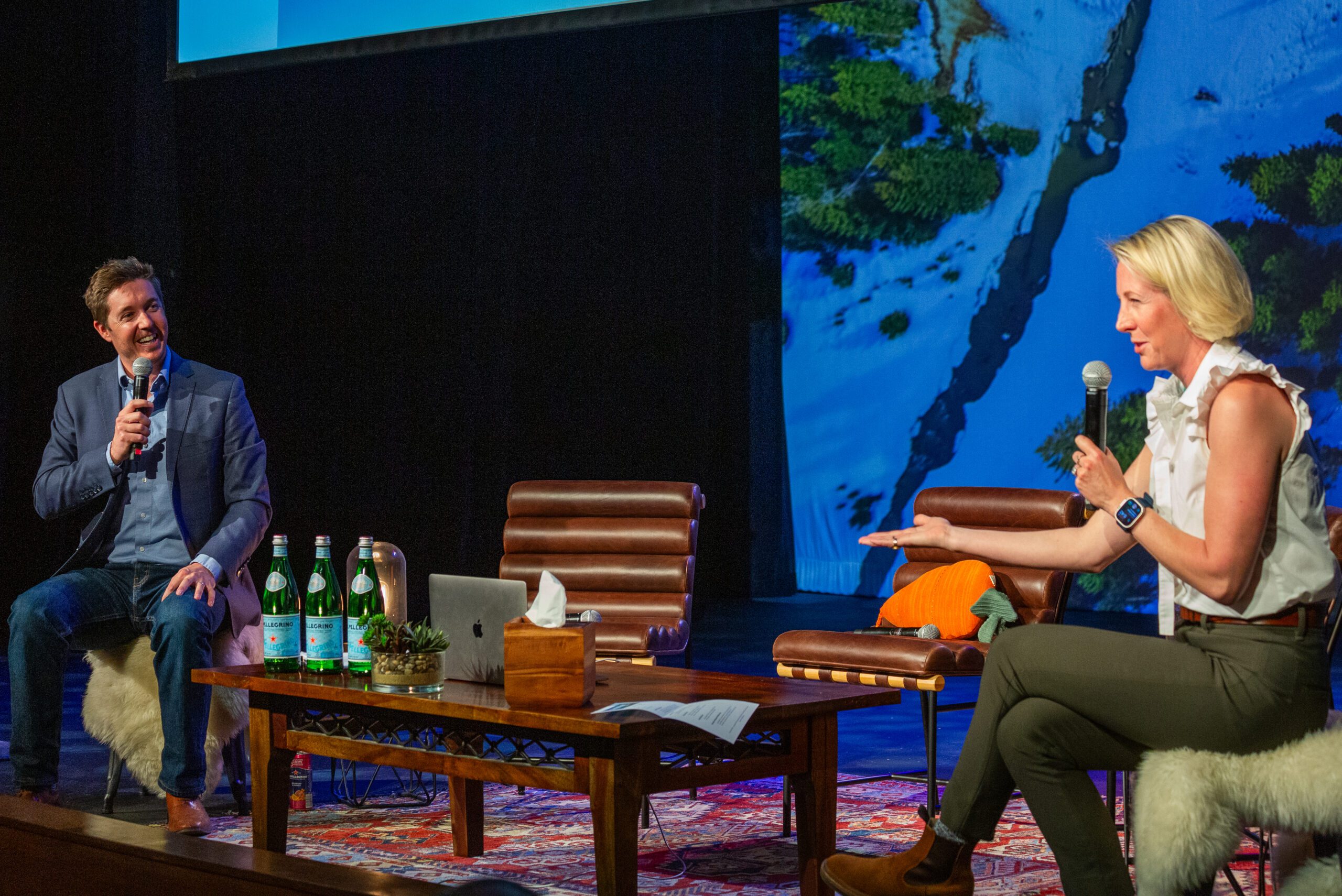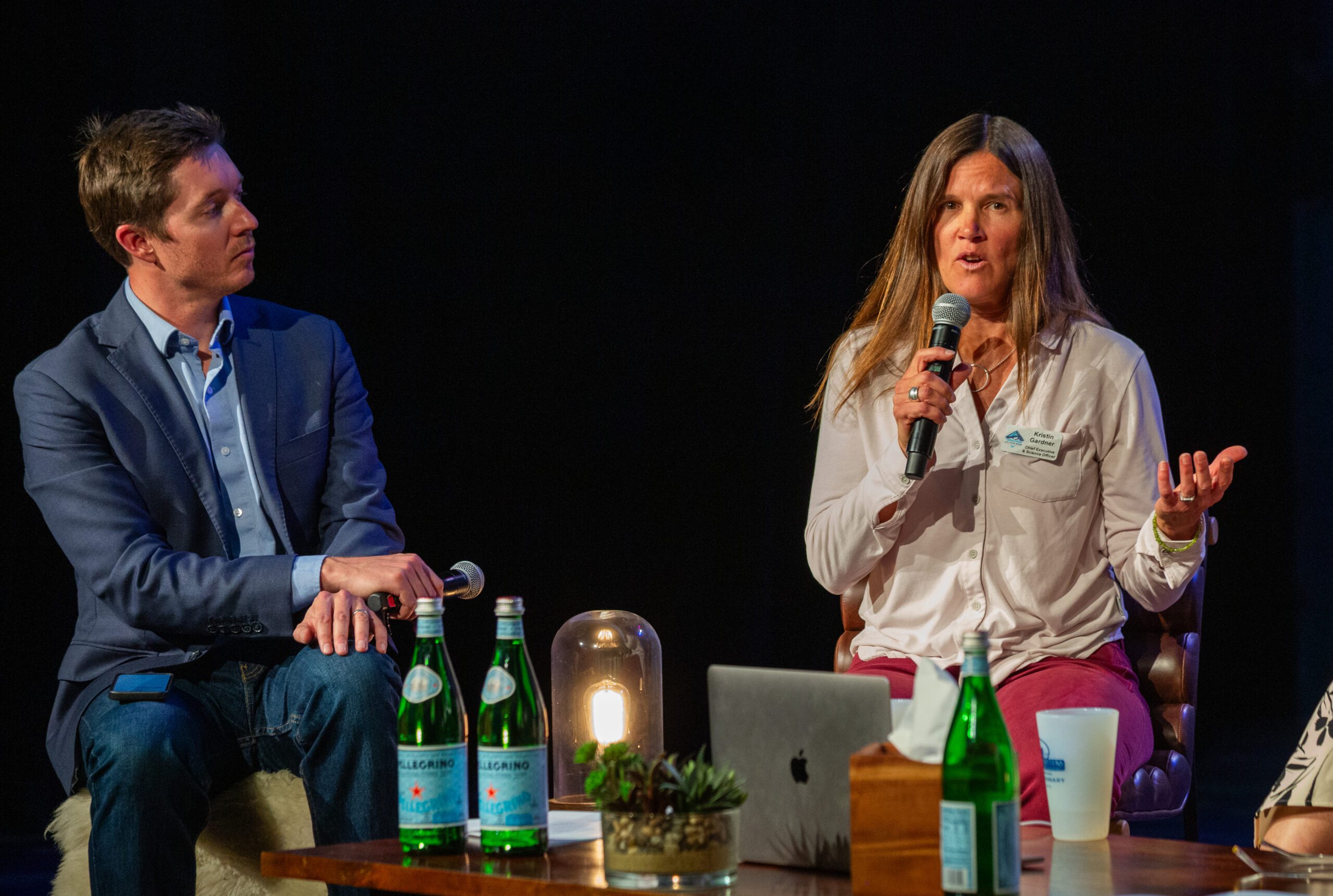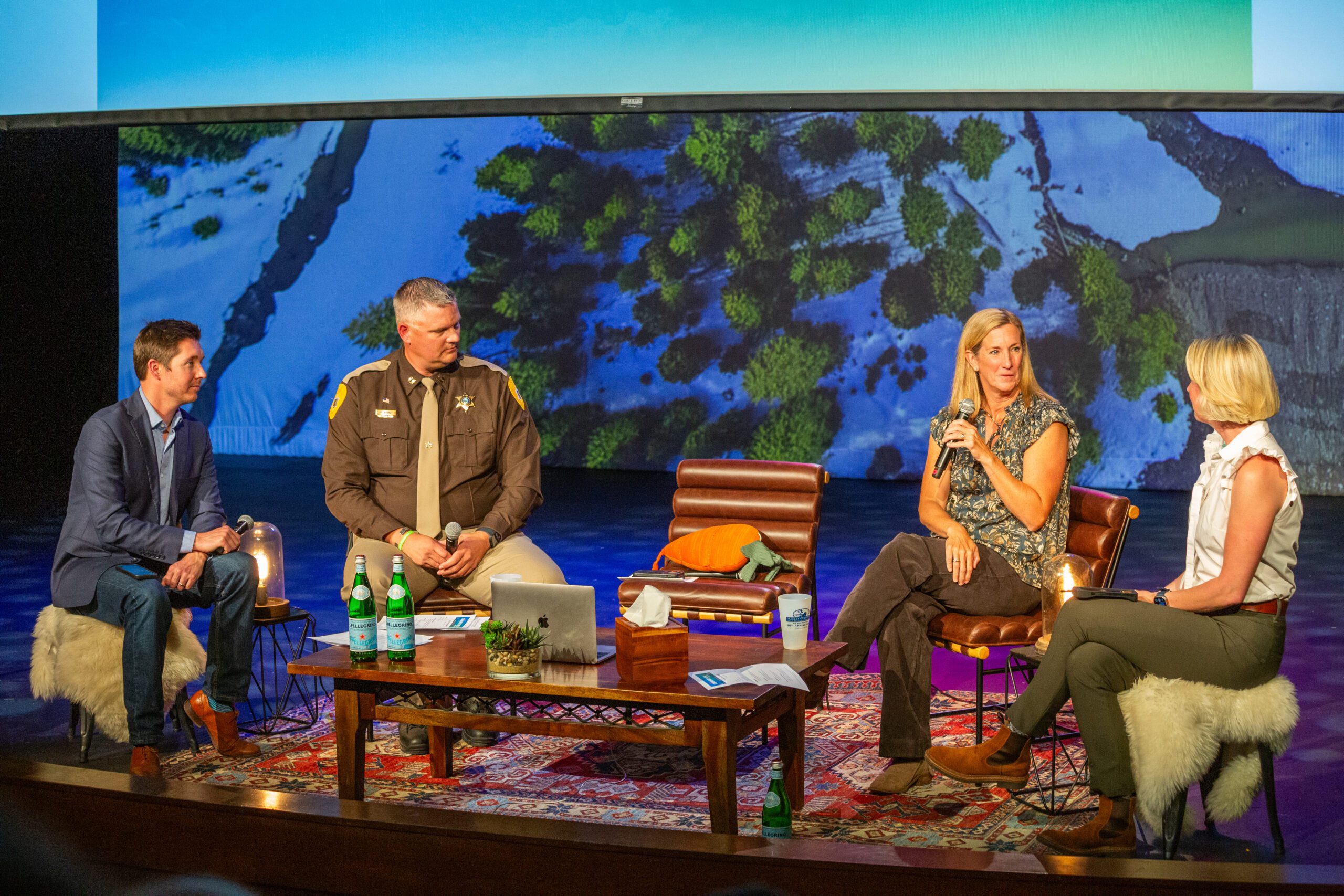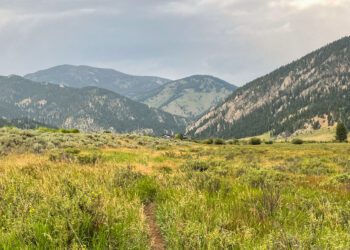WMPAC hosts 2024 State of the Community, featuring 13 business and nonprofit leaders
By Jack Reaney SENIOR EDITOR
On the evening of Tuesday, Oct 8, Big Sky Community Week hosted one of its prime-time events, the State of the Community, allowing attendees to learn a little bit about a lot during five panels of experts and leaders onstage at the Warren Miller Performing Arts Center.
For those unable to attend, the event was recorded and can be viewed here.
Liz McFadden and Jenny Christensen, who planned Community Week on behalf of the Big Sky Chamber of Commerce and Big Sky Resort Area District, respectively, said attendance on Tuesday night was strong and engaged many newer faces from the community. McFadden said one goal this year was to help elevate newer or lesser-known nonprofits and open the door to collaboration.
Christensen said this year’s format emphasized learning a little about a lot. “It was just overall a good event, and all the presenters were awesome, and our moderators nailed it.”

Moderators Tallie Lancey and John Zirkle were intentional in pulling the best and most true stories out of each panelist. Lancey believes the State of the Community allows open dialogue about Big Sky’s challenges—and its unfolding solutions—in a way that allows residents to envision staying in the community.
“I think it’s important because the spirit of it is uplifting,” Lancey told EBS. “I understand a lot of public sentiment is not very positive. And this is a space where we leave that aside. We have to.”
The goal was to provide attendees with a broad understanding, not a deep one. Adjusting from last year’s inaugural State of the Community, the moderators opted against taking verbal questions from the audience, instead encouraging attendees to send questions via text.
To simplify presentations, each panelist was asked to provide one number, one picture and one word to summarize the priorities of their organization.
Of the 13 panelists, four chose some form of “connection” as their word.
Asked about her own one-word summary of Tuesday’s event, Lancey told EBS it’s “pioneering.” She explained that she stays in Big Sky because it allows the opportunities of a modern-day pioneer.
“I feel the spirit of the American West in this room,” Lancey said. “Amy Vance, Brit Diersch—they are pioneers. They are solution oriented, collaborative, community oriented. I love bearing witness to the pioneer spirit.”
Recreation and conservation: ‘Still a lot of work to be done.’

Zirkle and Lancey began by welcoming three nonprofit leaders to the stage: Deb Davidson, chief strategy officer for the Center for Large Landscape Conservation; Whitney Montgomery, CEO of the Big Sky Community Organization, and Kristin Gardner, chief executive and science officer of the Gallatin River Task Force.
The recreation and conservation discussion can be viewed here.
Summarizing CLLC’s ongoing efforts in the area, Davidson explained why the nonprofit is applying for millions in federal funding. She said when the right kind of wildlife crossings are installed in the right place, it can reduce vehicle-wildlife collisions by 85%.
“Wildlife crossings are very expensive at the outset, but they pay for themselves way ahead of their 75-plus-year lifespan due to the cost savings of fewer wildlife vehicle collisions,” Davidson said.
Montgomery emphasized BSCO’s commitment to focus not only on parks, trails and facilities, but also as a community builder.
“This town is filled with passionate people who lean into things heavily,” Montgomery said, explaining what keeps him in Big Sky.
Gardner emphasized that Big Sky still has four “impaired” waterways: the Gallatin’s middle fork, west fork and south fork that all run through Big Sky, and the upper Gallatin River.
“I do want to give a big shoutout to our community,” Gardner said. “There’s been a lot of significant investment in addressing those issues… but there’s still a lot of work to be done.”
Her word was “resilient,” representing Big Sky’s response to growing environmental pressures.
During Q&A, Montgomery answered how recreation and conservation can coexist. He said the trails, forests and rivers that define much of the Big Sky community all require conservation.
“If we don’t conserve, we won’t have a place to recreate… If we don’t start thinking about how we protect our lands, and our conservation for everything, it’s all for naught—I mean, we’re going to go up in smoke someday if we don’t,” Montgomery said.
Health and safety: ‘Sometimes, slower is faster.’

Amy Vance, director of Big Sky Bandage, a nonprofit founded in 2023 to assist community members with medical expenses, was joined by Gallatin County Search and Rescue Commander Matt Boxmeyer for a discussion of health and safety.
The health and safety discussion can be viewed here.
Vance said 45 businesses and more than 100 local employees received assistance for medical bills in the nonprofit’s first year. She chose “healthy” as her word.
“I would see patients on a daily basis who live and work here, who would delay getting care and refuse care altogether because they couldn’t afford it,” Vance said. She thanked Big Sky Rotary for hosting Big Sky Bandage, and the “tremendous generosity” from Big Sky’s community foundations.
Boxmeyer said Gallatin County Sheriff’s Search and Rescue accounts for 3,484 volunteer hours every year. In 2023, GCSSAR served 110 people on 130 missions. His word was “service.”
“[Volunteers] go out in all types of weather, they’re prepared to stay out all night in snowstorms just to rescue you,” Boxmeyer said.
Discussing natural disasters during Q&A, Lancey encouraged community members to sign up for Gallatin County Emergency Management’s Community Notification System. Boxmeyer added caution regarding potential evacuation.
“Obviously there’s only so many ways into Big Sky,” Boxmeyer said. “So be patient, don’t run people off the road. Because if you get into an accident in the canyon everybody knows it can shut it down for quite a while.
“So sometimes, slower is faster.”
Arts and culture: opening doors

Three nonprofit leaders discussed arts and culture: Brian Hurlbut, executive director of the Arts Council of Big Sky; Brit Diersch, founder of Big Sky OUT; and Ann Swann, executive director of the World Language Initiative.
The arts and culture discussion can be viewed here.
Hurlbut looked back to 1988, when residents first came together to bring a Miami-based symphony to Big Sky.
“Fast forward to now, we feel like we are one of the leading arts nonprofits in southwest Montana,” Hurlbut said. He rattled off growth statistics in the past 10 years alone.
Diersch recalled the unexpected beginning of her LGBTQ organization, when more than 100 people attended a pride march organized by her friends.
“We kinda learned that there is an outlet needed for queer community to not only meet each other, but meet other people that also support them and welcome them in our town,” Diersch said.
Since becoming a nonprofit 10 months ago, Big Sky OUT has hosted 30 events. She looks forward to hosting Big Sky Resort’s first-ever queer ski weekend. Her word was “belonging.”
Swann said 841 students took foreign language programs in Big Sky and the Gallatin Valley, including 100 from Big Sky. She said especially in communities like Big Sky that welcome visitors and employees from around the world, language opens doors for people.
“Sixty percent of the world is bilingual or multilingual. Only 20% of the U.S. is multilingual or bilingual. And only 5% of Montana,” Swann said. “So that is why we do the work we do.”
Public works: ‘water-wise’

Mace Mangold, VP of WGM Group, and Rich Chandler, environmental VP for Lone Mountain Land Company, discussed public works.
The public works discussion can be viewed here.
Mangold discussed the ongoing effort to create central sewer in the Gallatin Canyon. He said the effort could remove two tons of nitrogen from the impaired Gallatin River.
“I would say the driving force of that algae growth is the nitrogen to the river contributed by septic [systems] in the canyon corridor,” Mangold said. He chose “water-wise” to summarize the Big Sky community’s interest in improving water-related infrastructure.
Chandler said Lone Mountain Land Company has reused 150 million gallons for irrigation and snowmaking, across all of its projects since November 2023.
“That’s water that otherwise would have been sourced with valuable drinking water,” Chandler said. “… It’s incumbent upon us as a community to manage this resource wisely, and to the highest levels technology can afford.”
In Q&A, Chandler added the Big Sky community should be proud.
“I would forecast here in the next five to 10 years: watch what happens with these other communities that become more water-scarce,” Chandler said. “They’re going to come asking for us, for help.”
Economic development and workforce: ‘Our peak is very much in the future.’

The final panel included Laura Seyfang, coordinator for Big Sky’s new Community Support Group for seasonal workers, Chad Wilson, Big Sky Resort’s VP of construction and development, and Matt Kidd, president of Lone Mountain Land Company.
The economic development and workforce discussion can be viewed here.
Seyfang continues to work toward creating a welcoming environment for Big Sky’s seasonal workers. Her word was “welcoming.”
“We want to make them really feel much more involved in the community,” Seyfang said. “… We appreciate them, we’re glad that they’re here, and we want to make them feel a part of our community.”
Wilson said Big Sky Resort still feels young. He talked about the near-completion of its “very ambitious” 10-year vision, Big Sky 2025.
“This type of investment in our brand experience has drawn people from all over the country, and all over the world to enjoy our resort both as teammates and as guests,” Wilson said. His word: “transformative.”
“Our vision is to lead the transformation of the American resort experience,” Wilson said.
Kidd talked about the word “development” in a positive light, despite community concerns.
“We’re proud of it. We are doing amazing things as a community, as an organization, we’re proud of the work we’re doing as a developer,” Kidd said.
He later added that construction and development is going to be “a way of life” and a reality for the near future of Big Sky, allowing the community to reach its potential.
“If people are totally against construction, I’m not sure Big Sky is the place for you,” Kidd said.
His word was “opportunity,” pointing out that many peer mountain towns have their best days in the rearview.
“Their peak… is in the past,” Kidd said. “But for Big Sky, like, our peak is very much in the future. What are we going to make of it? Let’s embrace the moment… Let’s make Big Sky all that it can be.”
The Q&A discussion focused on workforce housing, including defining the word “beds.” All three panelists have experience working to improve local housing resources.












